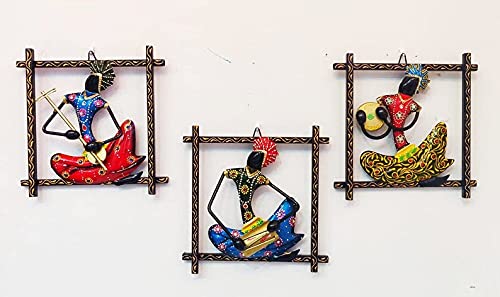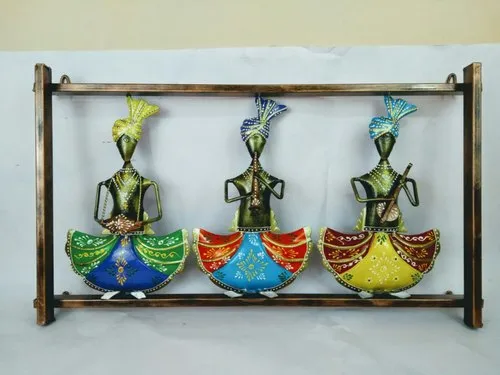Elevate Your Home with Indian Wall Hangings Decor: A Tapestry of Tradition and Elegance
India, a vibrant tapestry of diverse cultures, traditions, and spirituality, boasts a rich artistic heritage reflected in its unique decor. Among the defining elements of Indian interior design, wall hangings stand out for their ability to infuse homes with a sense of tradition and elegance. In this comprehensive guide, we will delve into the cultural significance of Indian wall hangings, explore the diverse styles and craftsmanship that define them, and discuss how these exquisite pieces can transform your living spaces into a sanctuary of beauty and tradition.
Cultural Significance of Indian Wall Hangings
Indian wall hangings transcend mere decoration, they are cultural artifacts carrying profound significance. These art pieces go beyond their aesthetic appeal, serving as visual narratives of India’s rich heritage. Mandalas, intricate geometric designs on Indian wall hangings, symbolize unity, harmony, and the cyclical nature of life. Mandalas contribute to the spiritual ambiance of Indian homes, connecting residents with their cultural roots. Depictions of gods, goddesses, and mythological narratives are common, enhancing the spiritual atmosphere and reflecting India’s diverse cultural tapestry.
The tapestry of Indian wall hangings becomes a storytelling medium, preserving and sharing the cultural richness that has evolved over centuries. Mandalas, with their symbolic resonance, become not just decorations but gateways to understanding the deeper philosophies embedded in Indian traditions.
Diverse Styles and Craftsmanship
Indian wall hangings are fascinating due to the unparalleled diversity in styles and craftsmanship. This diversity reflects India’s vast and varied cultural landscape, where different regions contribute their unique flavor, resulting in a captivating array of styles. Rajasthan, renowned for vibrant colors and mirror work, creates wall hangings that reflect the lively spirit of the desert state. In contrast, Kashmiri wall hangings showcase intricate threadwork and subtle colors, exuding sophistication. Exploring the diverse styles reveals a captivating journey through the craftsmanship of different Indian regions, each contributing to the rich artistic panorama.
The regional diversity not only showcases the craftsmanship but also serves as a testament to the adaptability and creativity embedded in Indian art. It’s a journey through colors, textures, and techniques that are as diverse as the country itself.

The Art of Block Printing and Embroidery
Two prominent techniques employed in creating Indian wall hangings are block printing and embroidery. Block printing uses intricately carved wooden blocks to stamp patterns onto fabric, resulting in visually stunning and symmetrical designs. The artistry lies not just in the final product but also in the meticulous process of creating these blocks. Each block is a work of art in itself, showcasing the skill and creativity of the artisan. Embroidery, another widely used technique, varies across regions. The vibrant threadwork of Gujarat and the delicate needlework of Uttar Pradesh add a tactile and luxurious dimension to the wall hangings.
The techniques employed in crafting these hangings are as intricate as the designs themselves. The art of block printing and embroidery not only adds visual appeal but also tells a story of skilled hands meticulously shaping each piece.
Transforming Your Living Spaces
Indian wall hangings have the transformative power to turn any living space into a sanctuary of elegance and tradition. The choice of a particular wall hanging can significantly impact the mood and aesthetics of a room. Hand-embroidered pieces bring a touch of opulence, while block-printed tapestries infuse vibrant energy. These wall hangings serve as focal points, telling visual stories that reflect the homeowner’s taste and appreciation for Indian art. Whether draped on walls, used as bedspreads, or fashioned into curtains, these hangings offer a versatile canvas for experimentation, allowing residents to integrate them into their home decor creatively.
The incorporation of these wall hangings becomes a conscious design decision, not just for aesthetics but for the cultural and emotional resonance they bring to a space. Each piece becomes a conversation starter, inviting guests into a visual journey through the diverse artistic expressions of India.
The Vibrancy of Colors
Colors play a pivotal role in Indian wall hangings, symbolizing a spectrum of emotions, traditions, and spirituality. Each color carries cultural significance, contributing to the overall narrative of the piece. Reds and yellows are associated with festivities and joy, while blues and greens evoke tranquility and a connection to nature. The intricate color combinations and patterns used in Indian wall hangings provide a versatile canvas for expressing a range of moods and themes. The careful selection and arrangement of colors showcase the artistry of the craftsman, making these hangings suitable for various decor styles and personal preferences.
The color palette becomes a language in itself, speaking volumes about the emotions and traditions woven into each piece. It’s not just about decoration but about creating a visual symphony that resonates with the cultural soul of India.

Maintaining the Timeless Beauty
Caring for Indian wall hangings is essential to preserve their timeless beauty. The longevity of these pieces depends on factors such as the materials used—whether cotton, silk, or wool—and the specific care they require. General guidelines include gentle hand washing or dry cleaning, avoiding prolonged exposure to direct sunlight, and storing them in a cool, dry place. By following these maintenance practices, homeowners can ensure that their Indian wall hangings remain a cherished part of their living spaces for generations to come. The commitment to proper care is a testament to the appreciation of the craftsmanship and cultural significance embodied in these exquisite pieces.
The act of caring for these pieces becomes a continuation of the respect and appreciation for the artistry and traditions encapsulated in each wall hanging. It’s a commitment to ensuring that the stories they tell continue to echo through time.
Where to Find Authentic Indian Wall Hangings
To bring the allure of Indian wall hangings into your home, it’s crucial to source them from authentic artisans and reputable sources. Local markets in India, especially in states known for their handicrafts, offer a vast array of choices. Exploring these markets provides an opportunity to directly engage with the artisans, gaining insights into the craftsmanship and cultural stories behind each piece. Additionally, online platforms that collaborate with Indian artisans and promote fair trade practices can be excellent sources for acquiring genuine and ethically crafted wall hangings. The key is to choose sources that prioritize authenticity and respect the cultural heritage associated with these art forms.
The sourcing of these wall hangings becomes a journey in itself, connecting the homeowner not just with a piece of decor but with the hands and stories behind each creation. It’s about building a bridge between cultures and supporting the artisans who keep these traditions alive.
Conclusion
In conclusion, Indian wall hangings are not just decorative elements; they are portals to a rich cultural heritage, weaving together traditions, craftsmanship, and spirituality. By incorporating these exquisite pieces into your home, you not only elevate your decor but also invite the stories of India’s diverse regions and communities into your living spaces. Whether you opt for the vibrant hues of Rajasthan, the intricate threadwork of Kashmir, or the block prints of Gujarat, each wall hanging becomes a testament to the timeless beauty of Indian artistry. Embrace the elegance, tradition, and vibrancy that Indian wall hangings bring, and let your home resonate with the spirit of this enchanting land. Through these captivating pieces, you can create a living space that tells a story—a story of tradition, elegance, and the timeless allure of Indian art.
